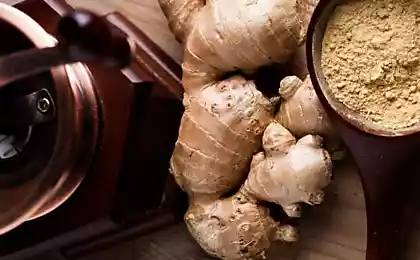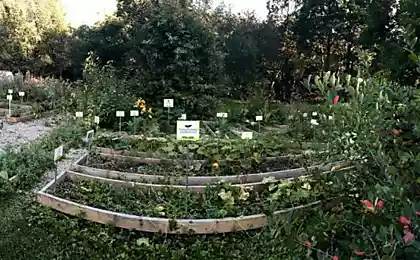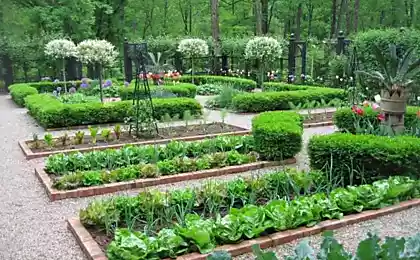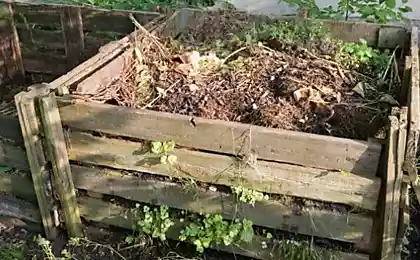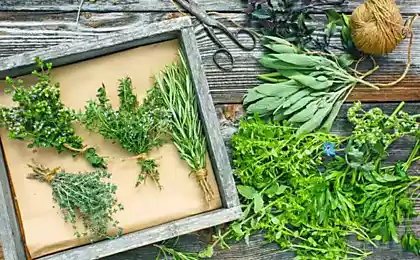224
How to grow ginger in the country
Ginger is a perennial herbaceous plant native to South Asia. Now it is massively grown in China, India, Indonesia, Australia, West Africa, Jamaica and Barbados.
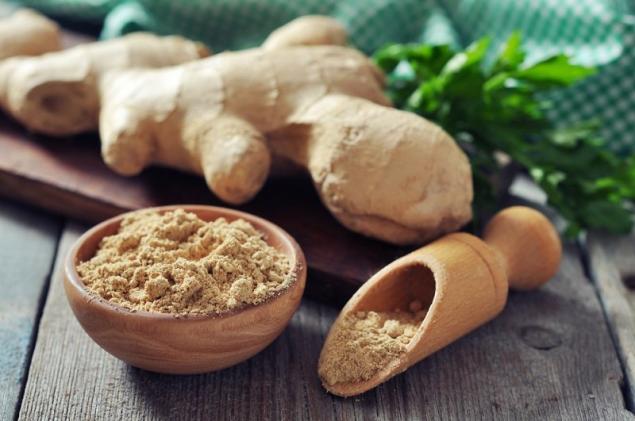
The use of this plant is truly extensive. Starting with pharmacy preparations, ending with your favorite seasonings for salad or meat, you can use ginger everywhere.
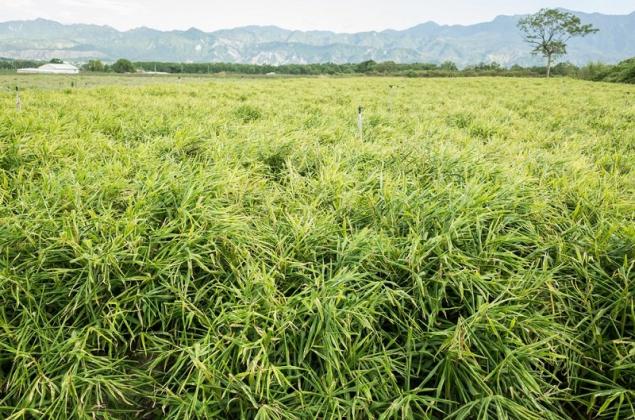
Despite the fact that ginger is not mass-grown, you can plant several dozen roots in your garden, and they will give a good harvest. Just follow our advice and you will no longer have to buy ginger for the winter in big supermarkets.
Ginger can be planted for several reasons: it is beautiful in itself, in a pot or on open ground. In addition, it is good in pickled form as a seasoning or as an ingredient for jams and jams. Ground ginger can be used as an additive to tea, and also from it make delicious ginger cookies:
The ingredients
Preparation

If our recipe has only strengthened your desire to grow some ginger, there will be a lot of useful information below on how to do it.
Seed material
In order to plant ginger, you will need quality roots from the nearest supermarket. Suitable material that has all the following features:
Obviously, the better the seed material will be, the greater the chances of a good harvest. To stimulate growth before planting, the roots of ginger should be kept for 2-3 hours in warm water or pink permanganate solution.
Soil.
The ideal soil for ginger consists of 2 parts of leafy humus, one part of river sand and one part of sod land. In addition, it needs to ensure good access to the sun and avoid stagnation of water and drafts.
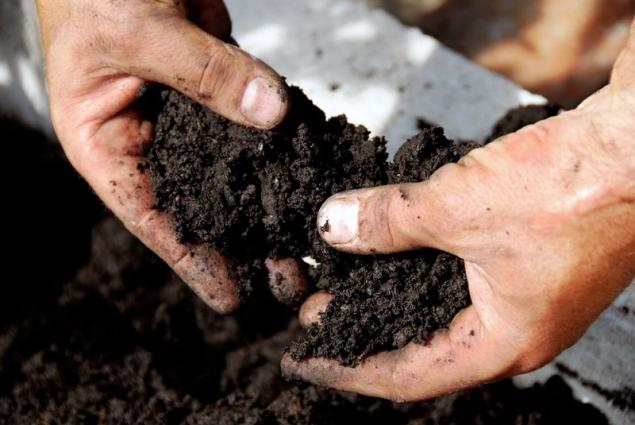
Ginger grows not only in beds, it is planted in large pots and as a hedge near a flowerbed. This way you can achieve the shade that some types of summer flowers like.
Landing time.
From the time of planting ginger in the ground and until the harvest takes about 9 months. Our summer does not last so long, so it is best to first plant ginger in a pot in mid-January.
If you’re only going to plant a few roots, you don’t have to take them out of the pot at all. Just treat it like a domestic plant, and it will delight you with its appearance and beautiful flowers.
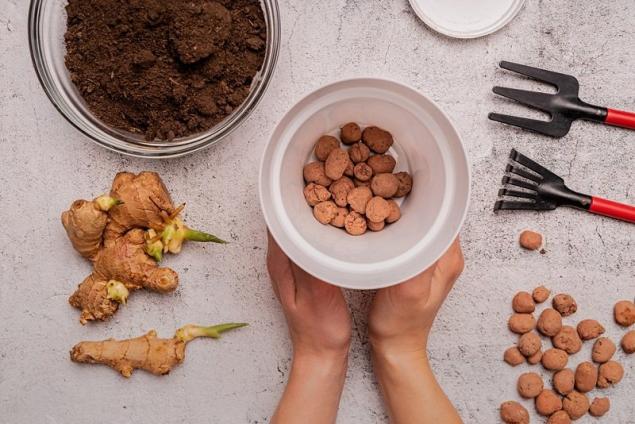
If you have serious plans, transplant ginger from the pot in late May, when the ground is already well warmed. The best temperature for landing is 25 degrees.
How to plant
If the planting root is more than 10 cm, it is cut into several parts. Slices are sprinkled with crushed coal or ash to prevent rotting.
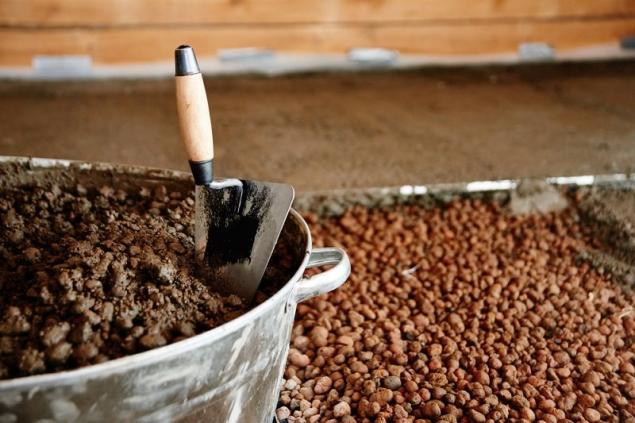
In a shallow pot (25 cm) mound a little soil, then a layer of ceramsite or other drainage material. Place suitable roots on top and cover with earth. Remember, ginger grows in width, not in length. After planting, pour the soil abundantly and repeat watering every 2 days before the sprouts appear. Then place the pot in a warm place with plenty of sunlight.
Plant care
After the first sprouts, the intensity of irrigation was reduced, but still keep the soil moist. Once a week, carefully loosen the top centimeter of the ground, trying not to disturb the roots.
In late May or early July, transplant the plant into open ground. Now to watering add spraying of leaves on especially hot days.
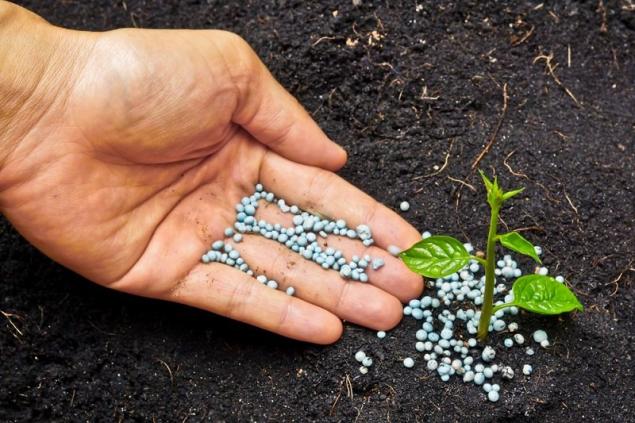
In the first half of summer, ginger loves organics. Fertilize it every 10–14 days at the rate of 0.5 liters per planted root. In August, closer to flowering, you can not do without phosphorus-potassium fertilizers. Suitable, for example, potassium monophosphate at the rate of 30-40 g per linear meter of planting. Add mineral fertilizers once a month until mid-September.
Diseases and pests
One of the main advantages of ginger is that it practically does not get sick. If its leaves turn yellow, it can mean either poor watering or insufficient amounts of nutrients in the soil.
The only pest for ginger is the spider mite. Its presence can be seen by the yellowed areas of the leaves and the thin web on them. Fighting the tick needs to be complex. In specialized stores, you can find many tools to combat this parasite.
Harvest
Ginger is picked in late autumn. Just don't water the plant for a couple of days. With a shovel or fork, remove roots from the soil and divide into separate pieces. Clean the ground, wash and dry.

Keep roots in the basement or refrigerator at a temperature not higher than 3-5 degrees and humidity below 80%. To prevent the crop from drying up, keep it in crates with wet sand or sawdust.
Another good option to clean ginger is to cut, dry or freeze. It will be preserved and its properties will not be lost.
As you can see, growing ginger at home or in the country makes sense: in winter, prices for this product fly up rapidly. And considering how useful. gingerThe return from him is absolutely colossal.
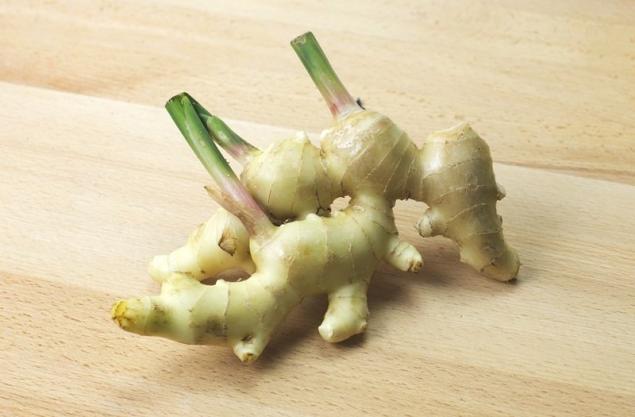
Ginger is an unpretentious plant. If you give him a little time at home or in a dacha, you will soon be able not only to enjoy his generous harvest, but even to distribute it to relatives, friends or neighbors!

The use of this plant is truly extensive. Starting with pharmacy preparations, ending with your favorite seasonings for salad or meat, you can use ginger everywhere.

Despite the fact that ginger is not mass-grown, you can plant several dozen roots in your garden, and they will give a good harvest. Just follow our advice and you will no longer have to buy ginger for the winter in big supermarkets.
Ginger can be planted for several reasons: it is beautiful in itself, in a pot or on open ground. In addition, it is good in pickled form as a seasoning or as an ingredient for jams and jams. Ground ginger can be used as an additive to tea, and also from it make delicious ginger cookies:
The ingredients
- 200g flour
- 1, 5 tsp soda
- egg
- 2 tsp ground ginger
- 1 tsp cinnamon
- 1 tsp cardamom
- 0.5 tsp cloves
- 100g butter
- 100g sugar
- 3 tsp honey
Preparation
- Cinnamon, cardamom and cloves shredded in mortar or blender. Mix ground ginger, cinnamon, cardamom, clove and soda. Ask them for flour. Next, rub the oil with sugar with a mixer. Add an egg and liquid honey to the oil mixture. Hit the butter again with a mixer, it'll be very lush.
- Mix the oil mass and flour with spices. It'll make a soft, sticky dough. Put it in the fridge or freezer for a couple of hours, this will facilitate further cooking. After cooling, divide the dough into several parts and roll it very thinly right on the parchment. With the help of molds, cut out the cookie blanks, leaving space between the cookies. Baking 6-7 minutes in the oven heated to 180 degrees. Hot cookies are soft at first, but quickly cool down and become hard. Don't keep him in the oven!

If our recipe has only strengthened your desire to grow some ginger, there will be a lot of useful information below on how to do it.
Seed material
In order to plant ginger, you will need quality roots from the nearest supermarket. Suitable material that has all the following features:
- Has growth buds (eyes like potatoes)
- smooth-skinned
- doesn't look dry
- no mucus on the cut
- no smell of rot
Obviously, the better the seed material will be, the greater the chances of a good harvest. To stimulate growth before planting, the roots of ginger should be kept for 2-3 hours in warm water or pink permanganate solution.
Soil.
The ideal soil for ginger consists of 2 parts of leafy humus, one part of river sand and one part of sod land. In addition, it needs to ensure good access to the sun and avoid stagnation of water and drafts.

Ginger grows not only in beds, it is planted in large pots and as a hedge near a flowerbed. This way you can achieve the shade that some types of summer flowers like.
Landing time.
From the time of planting ginger in the ground and until the harvest takes about 9 months. Our summer does not last so long, so it is best to first plant ginger in a pot in mid-January.
If you’re only going to plant a few roots, you don’t have to take them out of the pot at all. Just treat it like a domestic plant, and it will delight you with its appearance and beautiful flowers.

If you have serious plans, transplant ginger from the pot in late May, when the ground is already well warmed. The best temperature for landing is 25 degrees.
How to plant
If the planting root is more than 10 cm, it is cut into several parts. Slices are sprinkled with crushed coal or ash to prevent rotting.

In a shallow pot (25 cm) mound a little soil, then a layer of ceramsite or other drainage material. Place suitable roots on top and cover with earth. Remember, ginger grows in width, not in length. After planting, pour the soil abundantly and repeat watering every 2 days before the sprouts appear. Then place the pot in a warm place with plenty of sunlight.
Plant care
After the first sprouts, the intensity of irrigation was reduced, but still keep the soil moist. Once a week, carefully loosen the top centimeter of the ground, trying not to disturb the roots.
In late May or early July, transplant the plant into open ground. Now to watering add spraying of leaves on especially hot days.

In the first half of summer, ginger loves organics. Fertilize it every 10–14 days at the rate of 0.5 liters per planted root. In August, closer to flowering, you can not do without phosphorus-potassium fertilizers. Suitable, for example, potassium monophosphate at the rate of 30-40 g per linear meter of planting. Add mineral fertilizers once a month until mid-September.
Diseases and pests
One of the main advantages of ginger is that it practically does not get sick. If its leaves turn yellow, it can mean either poor watering or insufficient amounts of nutrients in the soil.
The only pest for ginger is the spider mite. Its presence can be seen by the yellowed areas of the leaves and the thin web on them. Fighting the tick needs to be complex. In specialized stores, you can find many tools to combat this parasite.
Harvest
Ginger is picked in late autumn. Just don't water the plant for a couple of days. With a shovel or fork, remove roots from the soil and divide into separate pieces. Clean the ground, wash and dry.

Keep roots in the basement or refrigerator at a temperature not higher than 3-5 degrees and humidity below 80%. To prevent the crop from drying up, keep it in crates with wet sand or sawdust.
Another good option to clean ginger is to cut, dry or freeze. It will be preserved and its properties will not be lost.
As you can see, growing ginger at home or in the country makes sense: in winter, prices for this product fly up rapidly. And considering how useful. gingerThe return from him is absolutely colossal.

Ginger is an unpretentious plant. If you give him a little time at home or in a dacha, you will soon be able not only to enjoy his generous harvest, but even to distribute it to relatives, friends or neighbors!







